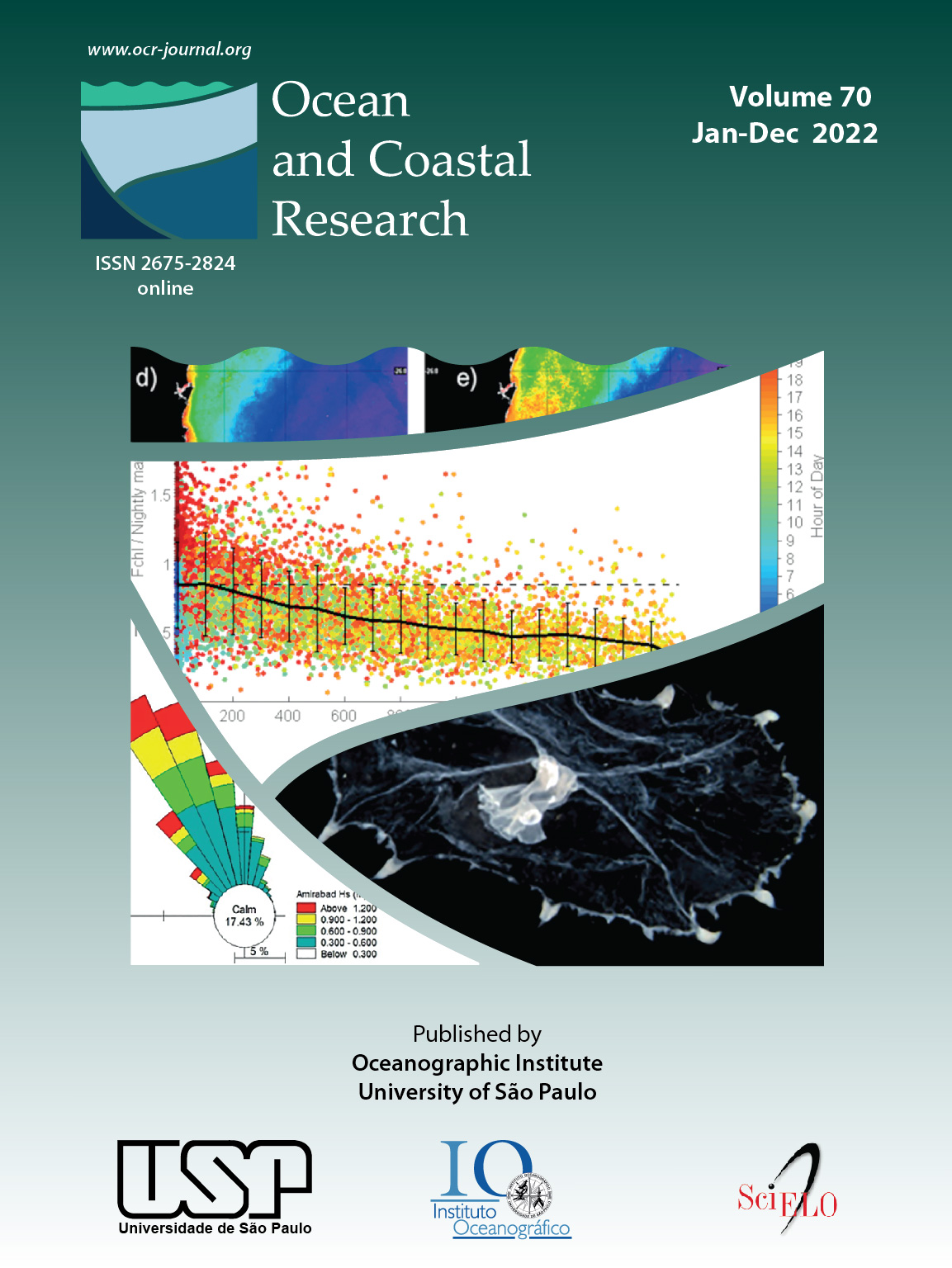Shark species identification from bite marks on a Short-finned Pilot Whale, Globicephala macrorhynchus
DOI:
https://doi.org/10.1590/Keywords:
Galeocerdo cuvier, Bite wounds, Cetacean, PredationAbstract
A Short-finned Pilot Whale, Globicephala macrorhynchus, was found dead and with shark bites along its body on a beach in northeast Brazil. The present study aimed to identify the shark species responsible for the bites as well as to estimate its/their total length. Species identification was performed using the bite marks, which were of the same diameter, suggesting they were infected by one or more Tiger sharks of similar size. The characteristics of the bites and the shape and distribution of the marks left by the teeth pointed to the Tiger Shark, Galeocerdo cuvier. The total length of the Tiger Shark or sharks was estimated at between 257 and 288 cm, based on the perimeter contour of each bite and the interdental distance inferred from the marks on the whale. This suggests that the bites were inflicted by one or more sub-adult specimens.
References
BORNATOWSKI, H., WEDEKIN, L. L., HEITHAUS, M. R., MARCONDES, M. C. C. & ROSSI-SANTOS, M. R. 2012. Shark scavenging and predation on cetaceans at Abrolhos Bank, eastern Brazil. Journal of the Marine Biological Association of the United Kingdom, 92(8), 1767-1772, DOI: https://doi.org/10.1017/S0025315412001154
» https://doi.org/10.1017/S0025315412001154
CLUA, E., BESCOND, P. M. & REID, D. 2014. Fatal attack by a juvenile tiger shark, Galeocerdo cuvier, on a kite-surfer in New Caledonia (South Pacific). Journal of Forensic and Legal Medicine, 25, 67-70, DOI: https://doi.org/10.1016/j.jfm.2014.04.005
» https://doi.org/10.1016/j.jfm.2014.04.005
CLUA, E., CHAUVET, C., READ, T., WERRY, J. M. & LEE, S. Y. 2013. Behavioural patterns of a tiger shark (Galeocerdo cuvier) feeding aggregation at a blue whale carcass in Prony Bay, New Caledonia. Marine and Freshwater Behaviour and Physiology, 46(1), 1-20, DOI: https://doi.org/10.1080/10236244.2013.773127
» https://doi.org/10.1080/10236244.2013.773127
CLUA, E. & REID, D. 2018. Contribution of forensic analysis to shark profiling following fatal attacks on humans. In: DOGAN, K. H. (eds.). Post mortem examination and autopsy - current issues from death to laboratory analysis London: Intech, pp. 57-75.
HEITHAUS, M. R. 2001a. Shark attacks on bottlenose dolphins (Tursiops aduncus) in Shark bay, western Australia: Attack rate, bite scar frequencies, and attack seaso-nality. Marine Mammal Science, 17(3), 526-539, DOI: https://doi.org/10.1111/j.1748-7692.2001.tb01002.x
» https://doi.org/10.1111/j.1748-7692.2001.tb01002.x
HEITHAUS, M. R. 2001b. Predator-prey and competitive interactions between sharks (order Selachii) and dolphins (suborder Odontoceti): a review. Journal of Zoology, 253(1), 53-68, DOI: http://dx.doi.org/10.1017/s0952836901000061
» http://dx.doi.org/10.1017/s0952836901000061
JEFFERSON, T., WEBBER, M. & PITMAN, R. 2015. Short-finned pilot whale. In: WEBBER, M. A., JEFFERSON, T. A. & PITMAN, R. (eds.). Marine mammals of the world: a comprehensive guide to their identification. 2nd ed. Cambridge: Academic Press, pp. 193-196.
JUCÁ-QUEIROZ, B., NETO, J. S., MEDEIROS, R. S., NASCIMENTO, F. C., FURTADO-NETO, M. A. D. A., FARIA, V. V. & RINCON, G. 2008. Cartilaginous fishes (class Chondrichthyes) of Ceará state, Brazil, Western Equatorial Atlantic - an update. Arquivos de Ciências do Mar, 41(2), 73-81.
LONG, D. & JONES, R. 1996. White shark predation and scavenging on cetaceans in the eastern North Pacific Ocean. In: KLIMLEY, A. P. & AINLEY, D. (eds.). Great White Sharks: the biology of Carcharodon Carcharias. Cambridge: Academic Press, pp. 293-307.
LOWRY, D., CASTRO, A. L. F., MARA, K., WHITENACK, L. B., DELIUS, B., BURGESS, G. H. & MOTTA, P. 2009. Determining shark size from forensic analysis of bite damage. Marine Biology, 156, 2483-2492, DOI: https://doi.org/10.1007/s00227-009-1273-3
» https://doi.org/10.1007/s00227-009-1273-3
NAESSIG, P. J. & LANYON, J. M. 2004. Levels and probable origin of predatory scarring on humpback whales (Megaptera novaeangliae) in east Australian waters. Wildlife Research, 31(2), 163-170, DOI: https://doi.org/10.1071/WR03086
» https://doi.org/10.1071/WR03086
OSLON, P. A. 2009. Pilot whales. In: WURSIG, B., THEWISSEN, J. G. M. & KOVACS, K. (eds.). Encyclopedia of marine mammals 3rd ed. Cambridge: Academic Press, pp. 847-852.
TUCKER, J. P., VERCOE, B., SANTOS, I. R., DUJMOVIC, M. & BUTCHER, P. A. 2019. Whale carcass scavenging by sharks. Global Ecology and Conservation, 19, e00655, DOI: https://doi.org/10.1016/j.gecco.2019.e00655
» https://doi.org/10.1016/j.gecco.2019.e00655
WELLER, D. W. 2009. Predation on marine mammals. In: WURSIG, B., THEWISSEN, J. G. M. & KOVACS, K. (eds.). Encyclopedia of marine mammals 3rd ed. Cambridge: Academic Press, pp. 923-932.
WHITNEY, N. M. & CROW, G. L. 2006. Reproductive biology of the tiger shark (Galeocerdo cuvier) in Hawaii. Marine Biology, 151, 63-70, DOI: https://doi.org/10.1007/S00227-006-0476-0
Downloads
Published
Issue
Section
License
Ocean and Coastal Research is an open-access journal available through SciELO (Scientific Electronic Library Online).
Ocean and Coastal Research journal title abbreviation is Ocean Coast. Res. and should be used in footnotes, references, and bibliographic entries.
All Ocean and Coastal Research scientific articles are freely available without charge to the user or institution. In accordance with the BOAI definition of open access, all contents are available to readers free of charge. Users may read, download, copy, and link to the full texts of the articles. They may be used for any lawful purpose without prior authorization from the publisher or the author, as long as proper credit is given to the original publication.
All Ocean and Coastal Research published scientific articles receive an individual Digital Object Identifier (DOI) persistent digital document identification.
All the content of the journal, except where otherwise noted, is licensed under a Creative Commons License type BY. Authors retain the copyright and full publishing rights without restrictions.
More information on intellectual property can be found here and on Scielo's Open Acess Statement.
Ocean and Coastal Research is listed in Publons and reviewers and editors can add their verified peer review and editing history to their Publons profile.
Ocean and Coastal Research is indexed in the Directory of Open Access Journals (DOAJ) and complies with principles of transparency and best practice for scholarly publications.
Ocean and Coastal Research is committed to the best standards in open-access publishing by adopting ethical and quality standards throughout the publishing process - from initial manuscript submission to the final article publication. This ensures authors that their work will have visibility, accessibility, reputation, usage, and impact in a sustainable model of scholarly publishing.




